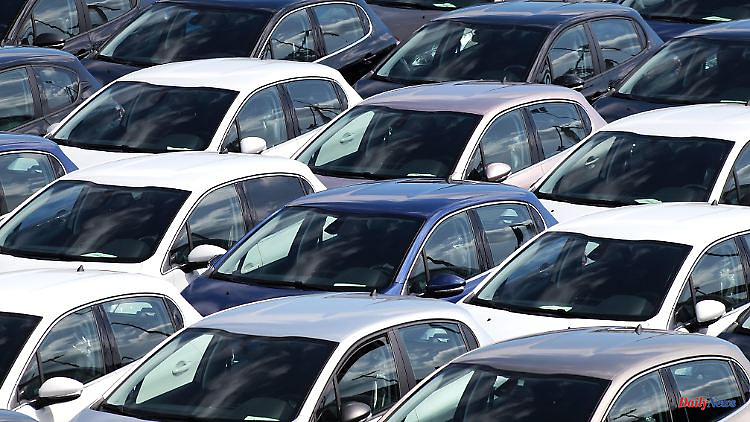Small vehicles were once the main business of many automakers. But you can earn more in the luxury class or with an SUV these days. But there are a few other reasons for the tendentially dwindling supply. This has consequences for buyers with less money - does this make mobility more elitist?
Small and micro cars take up less space, could make urban car traffic more efficient and reduce the impact on the climate. Some manufacturers stick to the segment - others rely on more profitable models.
Officially, the German industry also sees further opportunities for minis and small ones, especially those with electric motors. However, experts speak of a thinned out offer and one's own vehicle could become a luxury product. The causes and possible consequences of the trend are manifold.
In Germany, according to data from the Federal Motor Transport Authority, new registrations in December only declined for small cars, with the exception of minivans and mobile homes. They decreased by 4.1 percent compared to the same month last year. The share was 9.6 percent. The most popular model was the Opel Corsa. The microcars or minis, where the Fiat 500 led, achieved an increase of 15.7 percent - but with a share of only 7.1 percent of all new cars on the road. The booming SUV scored 34 percent.
If you look at the small and micro car segments together, the long-term trend becomes clear: between 2012 and 2022, the total share fell from almost 24 to just over 18 percent, as the “Handelsblatt” recently reported. The industry association VDA nevertheless assesses the situation positively. In the past year, there were more than 420,000 newly registered copies of small cars nationwide, almost a third of them with electric drives.
One conclusion of the car lobby: "In Germany, the proportion of small and very small cars is particularly high in battery-electric cars." Since e-mobility has picked up speed, also thanks to state-industrial subsidies, small, compact vehicles have even become more important. However, you have to see that in relation to other segments such as SUVs or off-road and sports cars - and the future of promoting e-cars is on shaky ground.
If you can sell a high-priced car at a high price, you usually make more profit than smaller cars. Because the production costs - based on the small ones - do not rise to the same extent as the final price. This business rule is simple. However, it could lead to the supply of city cars and short-distance cars being further reduced because large cars are more profitable. The profit margins - i.e. the proportion of sales that remain in the cash register - are more attractive for many marketable SUVs, sedans or luxury models.
Manufacturers only make good money with the little ones if they achieve very high sales figures. But the number of series offered is shrinking. In the case of Minis, it was halved in the German market from 24 to 12 within a decade. Cars such as the Ford Ka, Opel Adam and Citroën C1 were phased out. This also affects those Kleistwagen series that are on the road with combustion engines - the magazine "Auto Verkehr" counted a decrease from 17 to 8 from 2017 to 2022.
The trade journal points out that apart from VW, all other mini series come from abroad with Fiat, Renault, Hyundai/Kia, Toyota or Suzuki. Most recently, the VW Up could no longer be ordered as a combustion engine. Only its E variant appeared in the configurator - how long it will stay there is uncertain after earlier order stops. The situation will probably be "similar to last year", according to Wolfsburg. The waiting times had become so long because of the chip crisis that the smallest Stromer was temporarily dropped from the program.
Other providers are also struggling. At BMW, the compact e-pioneer i3 was launched in 2013, but there was little demand. It was only at the beginning of 2020 that the group followed up with the electric Mini and a few months ago with the iX1 - a small SUV. At Renault, boss Luca de Meo sees no direct continuation for the Twingo. And Ford Germany stops the production of the Fiestas in Cologne prematurely. "The SUVization is recognizable worldwide," says Stefan Bratzel from the Center of Automotive Management in Bergisch Gladbach. "In the luxury class, the sales trend remains strong - the market shares are likely to continue to shift from bottom to top."
Colleague Benedikt Maier from the Institute for the Automotive Industry in Geislingen explains: "In times of raw material shortages, it is a logical business decision to primarily bring the high-margin products."
The enormous increase in the price of energy and metal raw materials since the beginning of the Ukraine war and of electronic components since the Corona crisis is part of this story. "The usual price increases by the manufacturers have recently taken place at shorter intervals and to a greater extent," says Maier. The lower supply has increased the costs for entry-level models. The little ones are aimed at households that don't have much on the high edge, users of second vehicles or delivery and care services. The industry, on the other hand, often and willingly reserved the available chip contingents for its big ships.
The VDA sees major challenges in electronics. "Therefore, there may be an extension of the delivery times for individual models." Maier, however, believes that no significant relaxation is to be expected for key battery resources such as lithium and cobalt for the time being. "The relative cost of a battery in small cars has a greater impact than in the luxury class." Some VW dealers are concerned about future sales.
A senior manager of the second largest car group said in the fall: "Porsche, Audi or Bentley were served as they needed it. We built a few (VW) Polos, (Skoda) Fabias and (Seat) Ibizas less." In the meantime, however, chip availability has improved. In 2025, a small e-car in Polo size (ID.2) will start at 25,000 euros. "If it stays that way, the Polo and ID.2 will replace each other seamlessly," they are confident at the moment. Development budgets and necessary volume
It often takes years for a newly designed mass model to become profitable. In addition, new technologies are initially more competitive in the upper segment while they are still relatively expensive. So-called economies of scale are important for later breakthroughs - the ability to use sheer quantity to reduce costs to such an extent that even lower sales prices generate a profit. The VDA explains: "Due to economies of scale, the models will become cheaper in the future." Maier is not so convinced: "I don't assume that the established German manufacturers will actively want to open up the small (smallest) car segment in the medium term or even open up with 'budget car' concepts."
More economical combustion engines emit less CO2. In the case of small e-models, the lower consumption of resources should reduce the climate load. The prerequisite is that the battery is charged with green electricity - and with the expansion of renewable energies, climate protectionists are urging the federal government to speed things up significantly. During the chip crisis, many criticized that small e-cars had disadvantages compared to large ones.
Even the otherwise skeptical environmental protection organization Greenpeace praised Volkswagen's plans to extend the ID series downwards, which started in 2020. Traffic expert Benjamin Stephan was irritated, however, why the VW E-Up and small electric vehicles from other manufacturers were not prioritized beforehand.
On the other hand, companies emphasize that the stricter Euro-7 combustion engine emissions standard will increase the costs of small models in particular and make them less attractive. "The price increase resulting from the requested further developments will affect small cars in particular," warns the VDA.
Overly ambitious cleaning technology is relatively more important for the little ones. The representative of a large manufacturer criticizes the "lack of planning ability" for the coming years.
Many manufacturers insist that more models are needed to lead to certain brands. Also because the "shared" car is becoming more popular through subscription approaches, high new car prices can be partly offset.
However, Bratzel sees the danger that general inflation could drive out cheap cars per se: "The social dimension of auto-mobility needs to be discussed more. I can already see that the topic is perceived emotionally in layers with less money. We have to be careful that it doesn't backfire in terms of climate policy."












